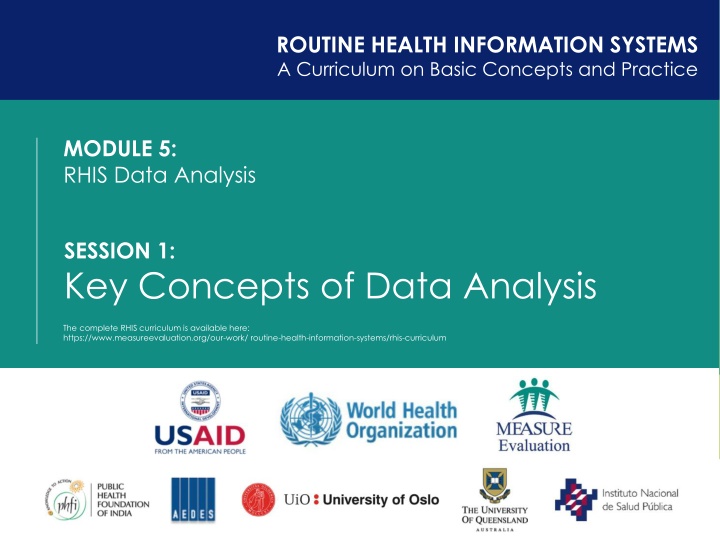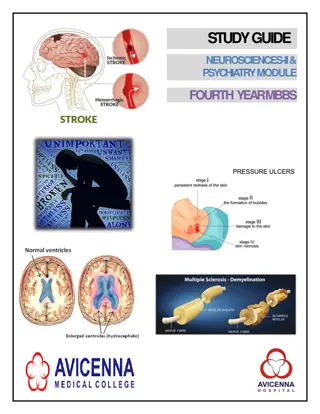
Key Concepts of RHIS Data Analysis: Understanding Techniques & Interpretation
Explore the essential concepts in data analysis for Routine Health Information Systems (RHIS) to enhance understanding and utilization of data for program evaluation and decision-making. Learn to define key concepts, use data analysis terminology, and select appropriate charts. Discover how to turn raw data into actionable insights and answer crucial program questions effectively.
Download Presentation

Please find below an Image/Link to download the presentation.
The content on the website is provided AS IS for your information and personal use only. It may not be sold, licensed, or shared on other websites without obtaining consent from the author. If you encounter any issues during the download, it is possible that the publisher has removed the file from their server.
You are allowed to download the files provided on this website for personal or commercial use, subject to the condition that they are used lawfully. All files are the property of their respective owners.
The content on the website is provided AS IS for your information and personal use only. It may not be sold, licensed, or shared on other websites without obtaining consent from the author.
E N D
Presentation Transcript
ROUTINE HEALTH INFORMATION SYSTEMS A Curriculum on Basic Concepts and Practice MODULE 5: RHIS Data Analysis SESSION 1: Key Concepts of Data Analysis The complete RHIS curriculum is available here: https://www.measureevaluation.org/our-work/ routine-health-information-systems/rhis-curriculum
Session 1: Learning Objectives Objectives By the end of this session, participants will be able to: Define key concepts of data analysis Use data analysis terminology Select the appropriate chart
Session 1: Topics Covered Topics Covered Descriptive analysis o Ratio, proportion, percentage, and rate o Median, mean, and trend Selection of the appropriate chart
Data Analysis Analysis: Turning raw data into useful information Purpose: To provide answers to questions being asked by a health program Even the greatest amount and best quality of data mean nothing if data are not properly analyzed or analyzed at all.
Data Analysis Analysis does not mean using a computer software package. Analysis is looking at the data in light of the questions you need to answer: How would you analyze data to determine: Is my program meeting its objectives?
Answering Program Questions Question: Is my program meeting its objectives? Analysis: Compare program targets and actual program performance to learn how far you are from the targets Interpretation: Why have you achieved or not achieved a target, and what does this mean for your program? Answering may require more information.
Descriptive Analysis Describes the sample/target population (demographic and clinical characteristics) Does not define causality; tells you what, not why Example: Average number of clients seen per month
Basic Terminology and Concepts Statistical terms Ratio Proportion Percentage Rate Mean Median Trend
Central Tendency Measures of the location of the middle or the center of a distribution of data Mean Median
Mean The average of your dataset The value obtained by dividing the sum of a set of quantities by the number of quantities in the set Example: (22+18+30+19+37+33) = 159 6 = 26.5 The mean is sensitive to extreme values
Calculating the Mean Average number of clients counseled per month 30+45+38+41+37+40 = 231 clients 231 clients 6 months = 38.5 January: February: March: April: May: June: 30 45 38 41 37 40 Mean = 38.5 clients/month
Median The middle of a distribution (when numbers are in order: that is, half of the numbers are above the median and half are below the median) The median is not as sensitive to extreme values as the mean. Odd number of numbers, median = the middle number Median of 2, 4, 7 = 4 Even number of numbers, median = mean of the two middle numbers Median of 2, 4, 7, 12 => (4+7) /2 = 5.5
Calculating the Median Client 1 2 Client 2 134 Client 3 67 Client 4 10 Client 5 221 Median of clients 1 5 = 67 Median of clients 1 4 = 100.5 (67+134=201/2 = 100.5)
Mean vs. Median: When to Use One or the Other? EXAMPLE 1 # patients / dr. Mean = ? Median = ? Facility 1 20 29.7 29 Facility 2 22 Facility 3 26 Facility 4 29 Facility 5 34 Facility 6 38 Facility 7 39
Mean vs. Median: When to Use One or the Other? EXAMPLE 1 # patients / dr. Mean = ? Median = ? Facility 1 8 50.8 40 Facility 2 38 Facility 3 39 Facility 4 40 Facility 5 45 Facility 6 46 Facility 7 140
Use the Mean or the Median? CD4 count Client 1 9 Client 2 11 Client 3 92 Client 4 92 Client 5 95 Client 6 100 Client 7 100 Client 8 101 Client 9 104 Client 10 206
Trend A trend is a pattern of gradual change in a condition, output, or process, or an average or general tendency of a series of data points to move in a certain direction over time, represented by a line or curve on a graph. To follow a trend you must not only be aware of what is currently happening but also be astute enough to predict what is going to happen in the future.
Calculating Trends Adults and children on antiretroviral therapy (ART), 2008 2011 200 180 # of people (in thousands) 160 140 120 # adults on ART # children on ART 100 80 60 40 20 0 2008 2009 2010 2011 19
Calculating Trends Adults on ART and children on ART, 2011 200 180 # of people (Hundreds) 160 140 120 100 # adults on ART # children on ART 80 60 40 20 0 20
Key Messages Purpose of analysis: Provide answers to programmatic questions Descriptive analyses describe the sample or target population. Descriptive analyses do not define causality. That is, they tell you what, not why. 21
5 QUESTIONS TO ASK YOURSELF WHEN CHOOSING A CHART
5 Questions to Ask Yourself When Choosing a Chart 1. Want to compare values? Charts are perfect for comparing one or many value sets, and they can easily show the low and high values in the data sets. Use these charts to show comparisons: Column/bar Circular area Line Scatter plot Bullet
5 Questions to Ask Yourself When Choosing a Chart 2. Want to show the composition of something? To show how individual parts make up the whole of something (such as the device used for mobile visitors to your website, or total sales broken down by sales rep) Use these charts to show composition: Pie Stacked bar Stacked column Area
5 Questions to Ask Yourself When Choosing a Chart 3. Want to understand the distribution of your data? Distribution charts help you to understand outliers, the normal tendency, and the range of information in your values. Use these charts to show distribution: Scatter plot Line Column Bar
5 Questions to Ask Yourself When Choosing a Chart 4. Interested in analyzing trends in your data set? If you want more information about how a data set performed during a specific period, there are specific chart types that do this extremely well. Use these charts to analyze trends: Line Dual-axis line Column
5 Questions to Ask Yourself When Choosing a Chart 5. Want to better understand the relationships among value sets? Relationship charts are designed to show how one variable relates to one or many different variables. You could show how something positively affects (or has no effect, or negatively affects) another variable. Use these charts to show relationships: Scatter plot Bubble Line
Examples of Charts to Choose When Analyzing Data % of HIV-positive women per region Column To show a comparison among different items To show a comparison of items over time
Examples of Charts to Choose When Analyzing Data Enrollment of HIV clients in ART in 3 regions Bar Should be used to avoid clutter when one data label is long or if you have more than 10 items to compare Can also be used to display negative numbers
Examples of Charts to Choose When Analyzing Data Number of clinicians working in each clinic in Years 1 4 Line A line chart reveals trends or progress over time. Can be used to show many different categories of data Use a line chart to show a continuous data set.
Examples of Charts to Choose When Analyzing Data Dual axis Used with 2 3 data sets, at least one of which is based on a continuous set of data, and another of which is better suited to being grouped by category Should be used to visualize a correlation, or the lack thereof, between these three data sets .
Example of Charts to Choose When Analyzing Data Enrollment of HIV clients in ART in 3 regions Area Useful for showing part-to-whole relationships, such as individual data s contribution to the total for a given period Helps you analyze both overall and individual trend information
Example of Charts to Choose When Analyzing Data Number of months female and male patients have been enrolled in HIV care, by age group Stacked bar Should be used to compare many items and show the composition of each one Represents components of a whole and compares wholes
Example of Charts to Choose When Analyzing Data Pie Represents percentages, with the segments totaling 100
Example of Charts to Choose When Analyzing Data Customer happiness, by response time Scatter plot Can show relationship between two variables, or reveal the distribution trends Should be used when there are many data points, and you want to highlight similarities in the data set Useful when you are looking for outliers or want to understand the distribution of your data
ROUTINE HEALTH INFORMATION SYSTEMS A Curriculum on Basic Concepts and Practice This presentation was produced with the support of the United States Agency for International Development (USAID) under the terms of MEASURE Evaluation cooperative agreement AID-OAA-L-14-00004. MEASURE Evaluation is implemented by the Carolina Population Center, University of North Carolina at Chapel Hill in partnership with ICF International; John Snow, Inc.; Management Sciences for Health; Palladium; and Tulane University. The views expressed in this presentation do not necessarily reflect the views of USAID or the United States government.
















